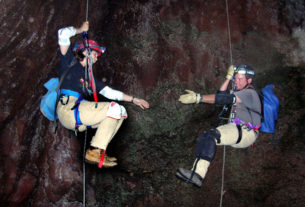Did You Know…?
Very few visitors to Guadalajara and, indeed, only a minority of Tapatios (Guadalajara residents), realize that several ancient pyramids, built more than a thousand years ago, still stand in silent pride even as they hear the noise and feel the rumble of the traffic on the city’s ring-road or periférico. The site of Iztépete is so close to where Mariano Otero joins the periférico that literally tens of thousands of people pass within 300 meters of it every day, yet there is not even a clear sign indicating its presence. What would these forgotten stone say, if they could talk!
None of the archaeological sites near Guadalajara is more interesting, or accessible, than Iztépete. Perhaps visitors who know the pyramids at San Juan Teotihuacan, near Mexico City, or those built by the Maya in the Yucatan may find Iztépete disappointing. But before dismissing these ancient mounds, intriguing sections of stairway and evocative walls, bear in mind that very few larger pre-Columbian stone constructions are known anywhere in western or northern Mexico and certainly none are as close to a major international airport, perennial tourist destination and lively, business-oriented city.
Mirrors, knives and obsidian
Some early references to the site spell it “Ixtépete”. For centuries, local inhabitants had passed the name down orally from one generation to the next. When archaeologists “re”-discovered the ruins and began exploring them in 1954, and heard its name, they were forced to choose between two alternative spellings: “Ixtépete” (derived linguistically from “ixtle”, the hard fibre made from the leaves of the maguey), and “Iztépete” (meaning “hill of obsidian or knives”). Obsidian is a hard, black, reflective, volcanic glass formed when lava cools instantaneously on falling into a lake. When fractured, pieces of obsidian acquire very sharp edges. Not surprisingly, many pre-Columbian peoples prized it for use as mirrors, arrow heads and knives. Given that large, angular chunks of obsidian litter the slopes of Cerro Colli, the hill rising behind the pyramids, “Iztépete” was deemed the more appropriate spelling.
The largest structure visible today, six meters high, conceals at least five preceding pyramids which had newer, bigger, pyramids superimposed over them. The steps up it are off-centre, an indication, perhaps, that more than one temple once adorned its top. The most recent, 12-meter-wide stairway, also superimposed over earlier versions, is probably more than a thousand years old! The earliest ceramics found at Iztépete suggest that occupation here stretches back at least to the fifth century AD.
Most of the walls visible today have the distinctive ” talud y tablero” form which characterizes the pyramids of Teotihuacan. Vertical sections ( tableros) with inset sections, which would have been plastered and painted, alternate with even sloping ” talud” sections. The proportions are not only esthetic and functional but also structurally sound.
Mysteries remain
Numerous unknowns remain at Iztépete. Who built these pyramids? Why here, and not elsewhere in the region? Why does the one patio seen by visitors today have the I-shape, always associated elsewhere with courts for the pre-Columbian ball game?
Of all the sites in Jalisco, this is the one which most deserves a visit. It also deserves continued conservation, restoration and investigation. And, of course, it also deserves better signposting for more publicity.
Shaft tombs in the Regional Museum
Visitors to Guadalajara interested in learning more about the area’s archeology can continue their discoveries by spending time in the city’s Regional Museum, housed in a historic building in the city center. Like almost all museums in Mexico, this is closed on Mondays and no entrance fee is charged on Sundays. The museum’s collection of pre-Columbian earthenware is outstanding and the museum is not so huge as to overwhelm the casual visitor. One particularly intriguing display shows the constructions known as shaft tombs, underground burial chambers dating from as long ago as 300 B.C. Such tombs have proved to be a rich source of archeological data. Some have interconnecting chambers excavated at different depths and multiple burials in a single tomb are common. It has even been worked out that some shaft tombs must have been constructed prior to the persons demise!
Even though Guadalajara may not have the spectacular pyramid sites the rest of the world associates instantly with Mexico, the city should still be on the travel itinerary of anyone interested in Mexico’s fascinating pre-Columbian past.

